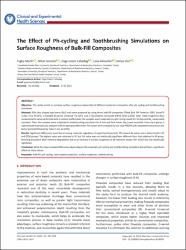| dc.contributor.author | Gönülol, Nihan | |
| dc.contributor.author | Almasifar, Lena | |
| dc.contributor.author | Misilli, Tuğba | |
| dc.contributor.author | Çabadağ, Özge Gizem | |
| dc.contributor.author | Dinç, Derya | |
| dc.date.accessioned | 2022-09-06T12:20:18Z | |
| dc.date.available | 2022-09-06T12:20:18Z | |
| dc.date.issued | 2021 | en_US |
| dc.identifier.citation | MİSİLLİ T,GÖNÜLO N,CABADAĞ Ö. G,ALMASİFAR L,DİNÇ D (2021). The Effect of Ph-cycling and Toothbrushing Simulations on Surface Roughness of Bulk-Fill Composites. Clinical and Experimental Health Sciences, 11(3), 487 - 494. Doi: 10.33808/clinexphealthsci.818099. | en_US |
| dc.identifier.issn | 2459-1459 / 2459-1459 | |
| dc.identifier.uri | https://doi.org/10.33808/clinexphealthsci.818099 | |
| dc.identifier.uri | https://hdl.handle.net/20.500.12712/33435 | |
| dc.description | Tam Metin / Full Text | en_US |
| dc.description | ESCI | |
| dc.description | WOS:000706782100017 | |
| dc.description.abstract | This study aimed to compare surface roughness values (Ra) of different posterior composites after pH-cycling and toothbrushing simulation. Methods: Fifty disc-shaped specimens (8x2 mm) were prepared by using three bulk-fill composites [Filtek Bulk Fill Posterior (FBF), SonicFill 2 (SF), X-tra fil (XF)], a flowable [G-aenial Universal Flo (GF)], and a microhybrid composite [Filtek Z250 (Z250)]. After initial roughness (Ra0 ) measurements were performed with a contact profilometer, the samples were subjected to a pH-cycling model for 10 days and Ra1 values were recorded. Then, the samples were subjected to toothbrushing simulation for 4 min and final values (Ra2 ) were recorded. From each group, a representative sample was analyzed with an optical profilometer. The values were analyzed by two-way ANOVA with repeated measures on one factor (period) followed by Tukey’s test (p<0.05). Results: Significant differences were found among materials regardless of experimental periods. The lowest Ra values were determined in GF and Z250 groups. The highest value was obtained in SF, but this value was not statistically significant different from that obtained in XF group. Brushing procedure after chemical degradation led to an increase in surface roughness of all materials except FBF, which was not statistically significant. Conclusion: While Ra values showed differences depending on the materials, pH-cycling and toothbrushing simulation did not have a significant effect on these values. | en_US |
| dc.language.iso | eng | en_US |
| dc.publisher | Marmara University | en_US |
| dc.relation.isversionof | 10.33808/clinexphealthsci.818099 | en_US |
| dc.rights | info:eu-repo/semantics/openAccess | en_US |
| dc.subject | bulk-fills | en_US |
| dc.subject | pH-cycling | en_US |
| dc.subject | resin-based composites | en_US |
| dc.subject | surface roughness | en_US |
| dc.subject | toothbrushing | en_US |
| dc.title | The effect of ph-cycling and toothbrushing simulations on surface roughness of bulk-fill composites | en_US |
| dc.type | article | en_US |
| dc.contributor.department | OMÜ, Diş Hekimliği Fakültesi, Restoratif Diş Tedavisi | en_US |
| dc.contributor.authorID | 0000-0002-7046-7154 | en_US |
| dc.contributor.authorID | 0000-0003-3493-0137 | en_US |
| dc.contributor.institutionauthor | Gönülol, Nihan | |
| dc.contributor.institutionauthor | Almasifar, Lena | |
| dc.identifier.volume | 11 | en_US |
| dc.identifier.issue | 3 | en_US |
| dc.identifier.startpage | 487 | en_US |
| dc.identifier.endpage | 494 | en_US |
| dc.relation.journal | Clinical and Experimental Health Sciences | en_US |
| dc.relation.publicationcategory | Makale - Uluslararası Hakemli Dergi - Kurum Öğretim Elemanı | en_US |
















